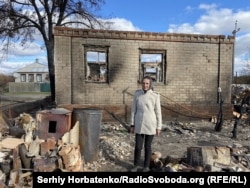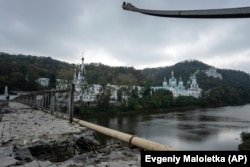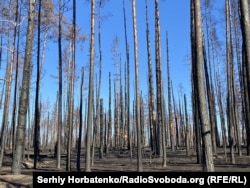KYIV -- In 2022, for the first time in her 34 years as a teacher, Lydia Prokopenko didn't get to see her first-graders graduate. Instead, her elementary school in eastern Ukraine was shut down, and she was forced into early retirement by a full-scale Russian military invasion.
Her home village, Studenok, was just kilometers from intense fighting in the nearby Holy Mountains National Nature Park, where Russian troops soon wrested control of the park's wooded cliffs. By the time Ukrainian forces recaptured the park in September 2022, it was heavily charred, pocked with blast craters, and criss-crossed with foxholes.
It was also strewn with land mines and unexploded ordnance that would fuel the largest wildfire in the Holy Mountains' history two years later, after a Russian air strike in September. Fire crews couldn't get a handle on the blaze for eight days as it scorched 7,000 hectares of the park and, eventually, took Prokopenko's home and much of her village with it.
"The fire spread so quickly. Such huge balls of fire were flying through the air...that our house couldn't be saved," she said. Now she lives with neighbors, and it's getting increasingly unlikely the 64-year-old former teacher will live long enough to see the Holy Mountains park or its wildlife recover.
Park director Serhiy Priymachuk and other Ukrainian officials say it is difficult to seriously consider restoring the Holy Mountains or any other ecosystem before the end of hostilities -- and even then, it will probably take decades. The park is located in a northern section of the Donetsk region that's been partially occupied by Russian-backed forces since 2014, and remains a theater of heavy fighting.
Ukrainian ecologist Volodymyr Yarotskiy offers a twist on the "butterfly effect" and unforeseen consequences, saying, "This is no longer a 'flap of wings,' this is really a fairly significant impact on the environment."
Accusations Of Ecocide
Since the start of the Russian invasion, the amount of Ukrainian forest destroyed by fire has shot up by a factor of 30, according to the All-Ukrainian Ecology League, an NGO.
The Environment Ministry says 800,000 hectares of forest have been consumed by conflict, including 2,400 hectares that is currently under Russian occupation. In those places, experts say, in addition to the trenches that Russian forces have dug, the occupiers have used the Ukrainian forests as a source for logging.
"From a total area of Ukrainian forest of 10.4 million hectares, almost 3 million hectares of forest has been affected by hostilities," Deputy Environment Minister Olena Kramarenko told RFE/RL's Ukrainian Service recently. "Just imagine that [an area] three-quarters the size of Switzerland was burned or destroyed by trenches."
Ukraine is working to hold Russia accountable for such destruction from the invasion, including for actions that Kyiv argues constitute ecocide -- unlawful or reckless acts committed knowing that there is a substantial likelihood of severe, widespread, or long-term damage to the environment. The Ukrainian Prosecutor-General's Office is already investigating 14 cases under the ecocide article of its Criminal Code, including the high-profile destruction in an explosion of the Kakhovka dam in southern Ukraine in June 2023.
Officials say that with each passing day of an invasion that recently hit the 1,000-day mark, Ukraine's ecological crisis worsens.
The Environment Ministry estimates damage to the Holy Mountains park so far at more than 16 billion hryvnyas ($385 million), with a clearer picture to emerge only once the war is over and explosives are cleared.
"Standing on the right bank of the Siverskiy Donets River" that winds through the park, Kramarenko said that due to fire "the forest looks more black than green."
"The land and the air are polluted," said park director Priymachuk, "there's nowhere for insects and birds to live."
Yarotskiy, a researcher at the Kreminna Woods National Nature Park in the nearby Luhansk region, notes that there are no more bats left in the Holy Mountains. "They performed an important function in the forest: They ate the same insects that can be dangerous to trees during reproduction," he told RFE/RL.
Larger animals perished or fled areas of intense fighting at the onset of the invasion, Yarotskiy said, seemingly evidenced by a rise in the populations of moose and deer in the Dnipro-Orylyk Nature Reserve to the west. It is a vicious sequence, he said: "Vegetation disappears, mouse-like rodents disappear. There are no rodents, there's no food base for [larger] predators."
Once vegetation reappears, Yarotskiy adds, rodent populations can then rise quickly with no predators to control their numbers and spread disease, including to humans.
Generations To Recover
Earlier this year, the Environment Ministry announced a plan to restore damaged areas of the Holy Mountains park. But then the massive fire struck, and plans have had to be abandoned or adjusted as the Russian Army continues to advance on the nearby front.
If the fighting ended tomorrow, according to Oleksiy Prykhodko, head of the Lyman Forestry state enterprise, it would still take 50-70 years to restore the areas' forests to their prewar condition. But he and ecologists who spoke to RFE/RL said that work could only begin once the more urgent problem of residual land mines was solved. Reuters reported that at least 14 forest rangers have died of shelling or mine blasts in the park; the Environment Ministry cited military secrecy in declining to provide an updated figure.
To date, Ukraine's State Emergency Service (DSNS) has managed to clear explosives from only about 2 percent of the Holy Mountains park, which is dotted with small settlements.
"According to statements from the Environment Ministry and Defense Ministry, the demining of forests won't begin for 10 years," said Serhiy Zibtsev, director of the Regional East European Fire Monitoring Center. "Because, let's say we have work [to de-mine] the fields and settlements and the roads for 10 years; in 10 years, the places that were restored with planting after the fire will be overgrown to the point where they'll be practically thickets."
Zibtsev says it's possible that the Holy Mountains might never be totally de-mined. He cites the examples of some Balkan countries where dangerous areas were simply made off-limits after the wars that followed the breakup of Yugoslavia. "They fenced off those forests, and that's it," Zibtsev said.
But he's quick to add that while the danger of mines in the national park might remain for at least another decade, nature can do some recovery on its own if it's left to its own devices.
"If you ask a lot of people, leaders, whether this forest will recover, in most cases they'll say that 'No, it won't recover, we need to plant forest [flora],'" Zibtsev said.
"That's not true. It will recover [on its own]; it will just take more time."














